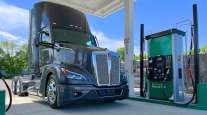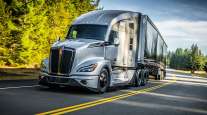Kenworth Showcases T680 Truck Models
This story appears in the June 30 print edition of Transport Topics.
CHILLICOTHE, Ohio — Kenworth Truck Co. is offering two variations on its T680 tractor that are targeted to fleets looking to reduce fuel costs, company executives said.
A fuel-efficiency package available with diesel-powered trucks promises a 5-6% improvement
in fuel economy versus a standard model, and a compressed natural-gas engine offers fleets the opportunity to expand use of a fuel that trades at a discount to diesel.
“We’re trying to stir up excitement for a full-vehicle spec that’s optimized for fuel economy,” said Brett VanVoorhis, Kenworth’s on-highway marketing manager. He was referring to the Kenworth T680 Advantage, which combines mechanical and aerodynamic changes to improve the truck’s fuel efficiency through weight reductions and design updates.
This truck and a CNG-powered variant were among several previewed during a June 20 press event at the company’s factory here.
The T680 Advantage is powered by a 13-liter Paccar MX-13 diesel that can be spec’d for up to 500 horsepower and 1,850 pound-feet of torque. The engine, VanVoorhis said, offers “the power of a 15-liter” but at a weight savings of 300 pounds. The standard T680 is available with a Cummins ISX 15-liter diesel, but that engine is not offered in the T680 Advantage.
The package also includes an Eaton Fuller Advantage automatic transmission that VanVoorhis said is 70 pounds lighter than an automated transmission offered in the truck. The Eaton unit, he said, has “optimized shift calibration” with “short-step” shift points to improve efficiency.
Those shifts are routed through a drivetrain that features a 6×2 rear-axle configuration that drives only the forward axle, leaving the rear axle to spin freely. This configuration eliminates the interaxle driveline and driveshaft, which VanVoorhis said cuts weight and eliminates parasitic losses.
Kenworth offers 6×2 axles from manufacturers Dana and Meritor, he said.
In addition, aerodynamic changes on the truck include longer side extenders for the truck’s 76-inch sleeper, a front air dam, a rear fairing without steps, exhaust cutout covers and optional aero wheel covers.
To round out the Advantage package, buyers must choose one of four options: wide-base, low-rolling-resistance tires; a tire-pressure monitoring system; an idle-management system; or a “smart” steering wheel.
The wide-base tires are SmartWay-certified and cut 300 pounds of weight on the truck, while the TPMS can maximize fuel economy by helping drivers ensure that tires are properly inflated, VanVoorhis said. He stated that a tire that is 10% underinflated can cut fuel efficiency by 1%.
“Tire-pressure monitoring won’t increase fuel economy, but it can help you get the fuel economy you should be getting,” he said.
The battery-based idle-management system powers electrical loads such as air conditioning in the sleeper, eliminating the need to run the engine for power. And the steering wheel incorporates cruise control buttons to make it easier for drivers to maintain a constant speed and potentially save fuel, he said.
Where the Advantage combines a series of changes to cut fuel costs, Kenworth’s natural-gas engine option offers entry into a segment of the alternative fuel marketplace that will grow in the years ahead, said Andy Douglas, Kenworth’s national sales manager.
“We are well past the science-project phase” with natural gas, he said. “The jury is not out; the jury is in, and this is happening.”
While Douglas acknowledged the natural-gas market for Class 8 trucks is in its infancy, he believes that 15-20% of heavy-duty trucks will use the fuel by 2020, up from
5-6% now. And price will be the driver, he said.
Douglas noted that compressed natural gas currently sells at a discount of between $1.50 and $2 per gallon below diesel. Looking ahead, he said the Energy Information Administration forecasts that the spread will stretch to $2 to $2.50 per gallon in the long term. And he said that shippers are taking notice and demanding that carriers take advantage.
“Fleets are getting pulled in by the shippers,” Douglas said. “That is going to be a big driver, because these [shippers] are looking for rate reductions.”
But costs of entry also will drop for fleets, he said, as economies of scale drive down the price of fuel systems.
“We are starting to see costs come down, which will lead to better [return on investment]. It is happening,” Douglas said. “This market is taking off on economics alone.”




